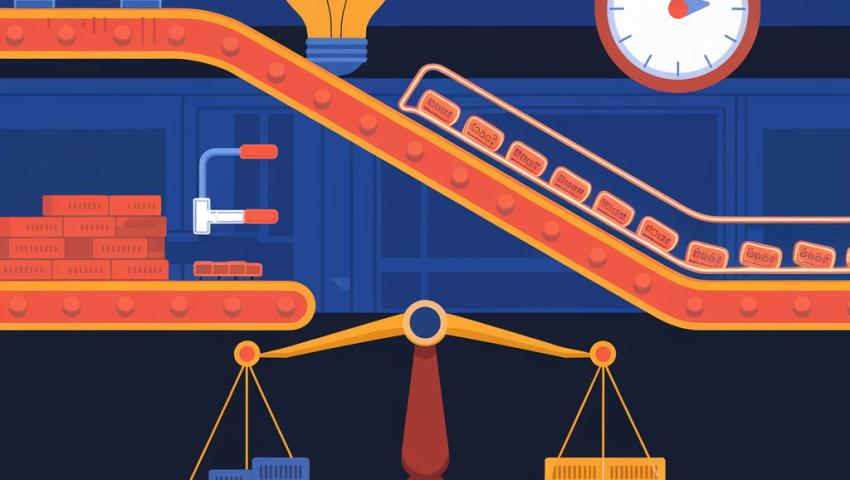
Understanding Current Ratio: A Business Case Scenario
The Current Ratio is a liquidity metric that evaluates a company's ability to cover its short-term liabilities with its short-term assets. It provides insight into whether a company has sufficient assets that can be quickly converted into cash to fulfill its immediate financial responsibilities.
In the competitive world of business, financial stability is crucial for survival and growth. One essential metric for assessing a company’s short-term financial health is the Current Ratio. This ratio provides insight into whether a company can cover its short-term obligations, making it a vital indicator for investors, creditors, and management. Let’s dive into the concept of the current ratio and explore its practical application through a real-world business scenario.
What is the Current Ratio?
The Current Ratio measures a company's ability to pay its short-term liabilities with its short-term assets. It serves as a quick check of the company’s liquidity position, helping stakeholders understand its financial health.
Formula:
Current Ratio = Current Assets / Current LiabilitiesCurrent Assets include cash, accounts receivable, inventory, and other assets expected to be converted into cash within one year.
- Current Liabilities are obligations that need to be settled within one year, such as accounts payable, short-term debt, and accrued expenses.
Interpretation:
A current ratio above 1 indicates that a company has more current assets than current liabilities, suggesting good liquidity.
A ratio below 1 signals potential liquidity issues, as the company may struggle to meet its short-term obligations.
- A ratio significantly above 2 might indicate inefficient use of assets, implying excess liquidity.
Significance of the Current Ratio
Liquidity Insight: The current ratio assesses a company’s ability to convert assets into cash to cover debts, offering a snapshot of its financial position.
Credit Evaluation: Lenders and investors use the current ratio to evaluate the risk of providing loans or investing in the company.
- Operational Efficiency Check: Management can analyze this ratio over time to assess how effectively they manage assets and liabilities.
Business Case Scenario: TechWare Solutions
Company Overview: TechWare Solutions, a software development firm founded 10 years ago, specializes in providing customized solutions for small and medium-sized enterprises. The company has diversified into hardware sales to complement its software services, leading to increased inventory. Efficient liquidity management has become essential due to fluctuating cash flow and growing liabilities.
Current Financial Snapshot:
| Item | Amount (USD) |
|---|---|
| Cash and Cash Equivalents | $120,000 |
| Accounts Receivable | $180,000 |
| Inventory | $300,000 |
| Prepaid Expenses | $50,000 |
| Total Current Assets | $650,000 |
| Accounts Payable | $210,000 |
| Short-term Debt | $130,000 |
| Accrued Expenses | $60,000 |
| Total Current Liabilities | $400,000 |
Calculating TechWare’s Current Ratio
Using the formula:
Current Ratio = Total Current Assets / Total Current LiabilitiesCurrent Ratio = 650,000 / 400,000Current Ratio = 1.625TechWare Solutions has a current ratio of 1.625. This means for every dollar of liability, the company has $1.63 in current assets, indicating a healthy liquidity position.
Scenario Analysis
Scenario 1: Boost in Sales and Increased Receivables
Let’s assume TechWare introduces a new line of software that rapidly gains market traction, leading to a boost in sales. To meet demand, the company extends more credit to clients, increasing accounts receivable to $250,000. At the same time, to support the surge in orders, the company incurs additional short-term debt, raising total liabilities to $480,000.
Updated Financials:
Total Current Assets = 120,000 (Cash) + 250,000 (Accounts Receivable) + 300,000 (Inventory) + 50,000 (Prepaid Expenses)Total Current Liabilities = 480,000Current Ratio = 720,000 / 480,000Current Ratio = 1.5- Interpretation: The current ratio has slightly decreased from 1.625 to 1.5, showing that while the company is still in a healthy liquidity position, the increase in liabilities and receivables requires careful monitoring. If customers delay payments, the company may face temporary cash flow constraints.
Scenario 2: Inventory Buildup Due to Market Slowdown
In this scenario, suppose TechWare experiences a market slowdown, leading to unsold inventory piling up. Inventory levels rise to $400,000, but current liabilities remain at $400,000.
Updated Financials:
Total Current Assets = 120,000 (Cash) + 180,000 (Accounts Receivable) + 400,000 (Inventory) + 50,000 (Prepaid Expenses)Current Ratio = 750,000 / 400,000Current Ratio = 1.875- Interpretation: The current ratio increased to 1.875, mainly due to the rise in inventory. However, high inventory levels can be a red flag, especially in tech industries where products can become outdated quickly. Excess inventory ties up capital that could be used elsewhere, and the company might need to implement strategies like discount sales or product bundling to reduce stock levels.
Best Practices for Maintaining an Optimal Current Ratio
- Enhance Cash Flow Management:
TechWare can implement tighter credit policies to reduce accounts receivable days. Offering early payment discounts can incentivize customers to pay sooner, improving cash flow.
- Improve Inventory Turnover:
Reducing inventory levels through better demand forecasting and adopting just-in-time inventory strategies can help free up cash. For TechWare, regularly reviewing inventory turnover can prevent excess stock from accumulating.
- Maintain a Balanced Current Ratio:
- Aiming for a current ratio between 1.5 and 2 is ideal for most businesses. A ratio below 1 indicates liquidity risk, while a ratio above 2 may suggest that the company is not utilizing its assets effectively.
Conclusion
The Current Ratio is a key financial metric that provides valuable insight into a company’s ability to meet its short-term obligations. For companies like TechWare Solutions, managing this ratio effectively is crucial for sustaining healthy liquidity and financial stability. By analyzing changes in the current ratio and understanding its components, management can make strategic decisions to optimize asset utilization and improve overall financial performance.
In the case of TechWare, while the current ratio of 1.625 shows a strong position, monitoring changes over time, especially during fluctuations in sales or inventory levels, can help the company respond proactively. By adopting best practices in cash flow and inventory management, businesses can maintain an optimal current ratio, ensuring they are well-prepared to handle both expected and unexpected financial challenges.
This balanced approach allows TechWare Solutions to leverage its assets efficiently, support growth, and secure the confidence of investors and creditors, thereby enhancing its competitive advantage in the marketplace.
Timo Kavuma
Leave a comment
Your email address will not be published. Required fields are marked *


